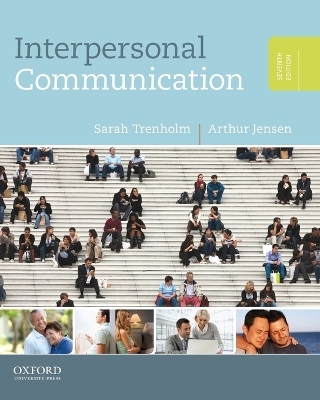
Interpersonal Communication
Oxford University Press Inc (Verlag)
978-0-19-982750-3 (ISBN)
Sarah Trenholm is Professor of Speech Communication at Ithaca College. Arthur Jensen is Professor of Communicaiton and Associate Dean of the College of Visual and Performing Arts at Syracuse University.
PART 1
Introductory Perspectives
Chapter 1: Communication and Competence
What is Communication?
Definitions of Human Communication
Characteristics of Communication
Communication is a Process
Communication is Uniquely Human
Communication is a Collective Activity
Communication is a Creative Endeavor
Communication is Regulatory
Summary and Implications
A Model of Communication Competence
Process Competence: Knowledge About Communication
Message Competence
Interpretive Competence
Role Competence
Self Competence
Goal Competence
Culture and Context
Historical Change and Cultural Values
How Technology Affects Cultural Context
Relational Cultures as Context
Performative Competence: Acting on Knowledge
Skill Building: On Taking a Process Perspective
Process to Performance
Questioning Communication Revisited
Review Terms
Suggested Readings
Online Student Resources
Observation Guides
Exercises
Interdisciplinary Connections 1: Bonzo Goes to College
Interdisciplinary Connections 2: Insulting the Meat
Research in Review: Getting the Most Out of College
Screening Room: Meet the Parents
Chapter 2: Building Interpersonal Relationships
What is Interpersonal Communication?
The Situational Approach to Interpersonal Communication
The Developmental Approach to Interpersonal Communication
The Role of Interpersonal Communication in Relationships
What is a Relationship?
The Characteristics of Relationships
Relational Paths: Intimacy and Distance
Private vs. Public Relationships
Independence vs. Conformity
What Does It Take To Be Relational Competent?
Communication Competence and Relationships
Some Characteristics of Healthy Relationships
Skill Building: A Preview
Process to Performance
Questioning Communication Revisited
Review Terms
Suggested Readings
Online Student Resources
Observation Guides
Exercises
Interdisciplinary Connections 1: The Neuroscience of Love
Interdisciplinary Connections 2: Mind Your Manners
Research in Review: Stress and Interpersonal Communication
Screening Room: Eternal Sunshine of the Spotless Mind
PART 2
Sending and Receiving Messages
Chapter 3: Nonverbal Communication
What is Nonverbal Communication?
Spontaneous Communication
Symbolic Communication
The Power of Nonverbal Codes
The Functions of Nonverbal Codes
Expressing Meaning
Modifying Verbal Messages
Regulating the Flow of Interaction
The Structure of Nonverbal Codes
The Visual Communication System
Proxemics
Environmental Preference
Territoriality
Personal Space
Kinesics
Body Movements
Types of Gestures
Gaze
The Expressive Function of Gaze
Using Gaze to Monitor and Regulate Interaction
Looking vs. Seeing
Facial Expression
Universal Expressions
Misreading Facial Expressions
Artifacts
Physical Appearance
Clothing and Adornment
The Auditory Communication System
Vocal Characteristics
Messages in the Voice
The Invisible Communication System
Chronemics
Olfactics
Haptics
Types of Touch
The Contexts and Functions of Touch
Culture and Nonverbal Communication
Balancing Nonverbal Codes
Expectancy Violations Theory
Cognitive Valence Theory
Compensating and Reciprocating in Everyday Life
The Interplay of Verbal and Nonverbal Communication
Skill Building: Communicating Feelings
Expressing Feelings
Reflecting Feelings
Process to Performance
Questioning Communication Revisited
Review Terms
Suggested Readings
Online Student Resources
Observation Guides
Exercises
Interdisciplinary Connection 1: A Better Place to Live
Interdisciplinary Connection 2:The Guarded Self
Research in Review: Pinocchio's Nose
Screening Room: Freaky Friday
Chapter 4: Language and Interpersonal Communication
What is Language?
How Verbal and Nonverbal Codes Differ
Characteristics of Verbal Codes
The Functions of Language
The Structure of Language
Semantic Meaning: Language at the Level of the Word
Denotative and Connotative Meanings
The Importance of Semantic Competence
Syntactic Meaning: Language at the Level of the Sentence
Order as Meaning
The Importance of Syntactic Competence
Pragmatic Meaning: Language at the Level of the Speech Act
Language in Use
Interpreting and Producing Speech Acts
Using Pragmatic Rules in Interaction
Message Production: Achieving Pragmatic Goals
Language, Power, and Politics
The Sapir-Whorf Hypothesis
Language and Labels
Identity and Language Use
Social Class and Discourse
Gender and Discourse
Early Findings
Later Criticisms
Language, Domination, and Freedom
Avoiding Sexist Language
Skill Building: Initiating Conversation
Starting to Talk
Finding a Topic
Asking Questions
Using Free Information during Conversation
Closing Conversations
Process to Performance
Questioning Communication Revisited
Review Terms
Suggested Readings
Online Student Resources
Observation Guides
Exercises
Interdisciplinary Connection 1: Speaking with Names
Interdisciplinary Connection 2: From Raillery to Rant
Research Review: Please and Thank You, Two Magic Words
Screening Room 1: The King's Speech
Chapter 5: Listening
What is Listening?
Listening vs. Hearing
The Listening Process
Beyond Accuracy: Listening Relationally
Listening and the New Technologies
Ways of Listening
Types of Listening
Listening Styles
What Should We Listen For?
Conflict Management and Effective Listening
When are Conflicts Healthy?
Why Are Conflicts Difficult to Manage?
Hot Emotions
Biased Perceptions
Communication Obstacles
Personal Differences in Conflict Management
Attitudes about Human Nature
Emotional Intelligence
Skill Building: Becoming a More Competent Listener
Improving Comprehension and Evaluation
Enhancing Empathic Listening
Process to Performance
Questioning Communication Revisited
Review Terms
Suggested Readings
Online Student Resources
Observation Guides
Exercises
Interdisciplinary Connections 1: Hot Under the Collar or Cool Under Fire
Interdisciplinary Connections 2: Do Crows Really Use SUVs to Crack Nuts?
Research in Review: When Parents and Children Don't See Eye to Eye
Screening Room: About a Boy
Chapter 6: Perceiving and Interpreting Social Worlds
Factors that Affect the Way we See the World
Emotions and Perception
Motivation and Perception
Cognitive Structures and Perception
Schematic Thinking and Information Processing
Schemata that Describe and Classify People
Personal Constructs
Person Prototypes and Stereotypes
Stereotypes
Schemata that Define Roles and Relationships
Schemata Containing Information about the Self
Schemata that Tell Us What to Do in Social Situations
Social Cognition and Interpersonal Interaction
Sizing up Situations
Episode Identification
Using Scripts to Guide Interaction
The Invisibility of Situational Constraints
Perceiving Other People
Using Personal Constructs to Judge Others
Implicit Personality Theories and Interaction
Evaluating Relationships
Self-Monitoring
Creating Relational Definitions
Explaining Behavior by Making Attributions
Personality vs. Situation
Attributional Biases
Overestimating Personality
Underestimating the Situation
Seeing Things from Our Own Perspective
Categorical Thinking and Interpretive Competence
Naïve Realism: Seeing What We Believe
Dual Processing and Impression Formation
Attention and Identification
Controlled Categorization
Personalization
Skill Building: Becoming More Mindful
Mindfulness and Open-Mindedness
Increasing Mindfulness
Process to Performance
Questioning Communication Revisited
Review Terms
Suggested Readings
Online Student Resources
Observation Guides
Exercises
Interdisciplinary Connection 1: The Power of the Present
Interdisciplinary Connection 2: Making Sense by Using Reflections and Interpretations
Research in Review: When Being Mindful Really Matters
Screening Room: Memento
Chapter 7: Meeting Social Expectations
Creating Social Identities
Social Control and Conformity
The Nature of Social Roles
Choosing Our Roles
Social Support and Role Identity
The Looking-Glass Self
Social Comparison Processes
Commitment and Role Identity
Rewards and Role Identity
How Social Roles Affect Communication
Communication as Performance
Face-Work and the Social Self
Other Aspects of Everyday Performance
Sets, Costumes, and Props
Backstage Behavior
Ensemble Acting
Communication as Story-telling
Skill-Building: Showing Politeness and Respect
Interpersonal Sensitivity
Avoiding Threats to Face
Balancing Solidarity and Independence
Process to Performance
Questioning Communication Revisited
Review Terms
Suggested Readings
Online Student Resources
Observation Guides
Exercises
Interdisciplinary Connection 7.1: They Just Like to Be Not the Same as Us
Interdisciplinary Connection 7.2: Talking Tough in Teamsterville
Research in Review 7.1: Guys Can't Say That to Guys
Screening room 7.1: Big Fish
Chapter 8: Establishing Individual Identities
The Self in History
Self Concepts: Gaining Independence from Social Roles and Rules
What is the Self-Concept?
Self as Narrative
Self as Cognitive Schema
Self as Behavior
Self as Relational Achievement
Self as Internal Dialogue
Personality Differences and Interpersonal Communication
Communicator Styles
Rhetorical Sensitivity
The Noble Self
The Rhetorical Reflector
The Rhetorical Sensitive
Communication Apprehension
Attachment Styles
Intimacy Motivation
Skill-Building: Improving Competence Through Self-Disclosure
What is Self Disclosure?
General Rules for Revealing the Self
A Case Study in Disclosure: Coming Out
How to Reveal Same Sex Orientation
What to Say When a Friend Comes Out
Process to Performance
Questioning Communication Revisited
Review Terms
Suggested Readings
Online Student Resources
Observation Guides
Exercises
Interdisciplinary Connection 1: The Saturated Self
Interdisciplinary Connection 2: Zen and the Art of Selflessness
Research Review: Presentation of Self in Cyberspace
Screening Room 1: Big Eden
Chapter 9: Achieving Personal and Relational Goals
What is Interpersonal Influence?
Types of Influence
Culture and Influence
Issues in Influence
Skills for Goal Achievement
Face and Interpersonal Influence
Symbolic Role-Taking
Theories of Influence; Understanding Others' Needs
The Need for Rewards
Classical Conditioning
Operant Conditioning
Social Learning
Social Exchange Processes
The Need for Consistency
Cognitive Dissonance Theory
Ways to Reduce Dissonance
Commitment and Consistency
The Need to Establish Identity
Value Theory
Relationships and Self Validation
Summary: Choice and Motivation
Source Characteristics
Power and Interpersonal Influence
Self-Presentation Strategies
Influence as Self-Persuasion
Message Strategies
Compliance-Seeking Strategies
Strategies in Interaction
Skill Building: Steps to Goal Achievement
Principles of Goal Competence
Becoming Appropriately Assertive
Process to Performance
Questioning Communication Revisited
Review Terms
Suggested Readings
Online Student Resources
Observation Guides
Exercises
Interdisciplinary Connection 1: Weapons of Influence
Interdisciplinary Connection 2: What's in a Name?
Research in Review: Wait 'Till you Hear What I Heard
Screening Room: Thank You For Smoking
PART 3
Relational contexts
Chapter 10: Understanding Family Relationships
Maintaining Family Ties
The Family as a System
Family Structures
Power-Authority Structure
Decision-Making Structure
Interaction Structure
Characteristics of Family Structures
Role Differentiation
Boundaries
Coordination of Subsystems
The Functions of the Family
Internal Functions
Providing Care
Socialization
Intellectual Development
Recreation
Emotional Support
External functions
Cultural Transmission
Accommodation
Families and Change
The Dynamics of Family Evolution
The Family Life Cycle
Stressful Contact with Outside Sources
Illness or Death of a Family Member
Divorce or Separation of Family Members
Strategies for Coping with Change
Anticipating Change
Encouraging Family Cohesiveness
Maintaining Adaptability
Building Social Networks
Family Communication Patterns
Family Rules and Family Identity
Establishing Communication Rules
Regulative Rules
Constitutive rules
Family Themes and Identity
Interaction in Family Subsystems
Husbands and Wives
Parents and Children
Siblings
Families in History
Skill Building: Communicating to Comfort
Process to Performance
Questioning Communication Revisited
Review Terms
Suggested Readings
Online Student Resources
Observation Guides
Exercises
Interdisciplinary Connection 1: Creating Hallmark Moments
Interdisciplinary Connection 2: Divorce is When Your Family is Dead
Research in Review: You're My Parent But You're Not
Screening Room: The Kids Are All Right
Chapter 11: Creating Intimate Relationships
What is Intimacy?
Have People Always Had Intimate Relationships?
Moving from Public to Private Relationships
Factors that Influence Definitions of Intimacy
` Family Messages
Recent Cultural Messages
Environnemental Conditions
Individual Relational Messages and Intimacy
Sending Dominance Messages
Dimensions of Intimacy
Relational Contracts and Cultures
Opening the Door to Intimacy: Interpersonal Attraction
Duck's Filtering Theory of Attraction
Interpersonal Magnets
Physical Beauty
Similarity
Reciprocal Liking
Complementary Needs
Costs and Rewards
Other Sources of Attraction
Coming Closer: Creating Intimate Relationships
Stages in the Development of Romantic Coupling
Initiating
Experimenting
Intensifying
Integrating
Bonding
The Development of Friendship
Rawlins' Friendship Stages
Types of Friendships
Keeping It Together: Relational Maintenance
Balancing Relational Dialectics
The Expressive-Protective Dialectic
The Autonomy-Togetherness Dialectic
The Novelty-Predictability Dialectic
The Gender Role Dialectic
Working Out Dialectic Tensions
Perceptual Biases during Maintenance
Relational Maintenance Behaviors
Too Close for Comfort: When Relationships Self-Destruct
Stages in Relational Deterioration
Differentiating
Circumscribing
Stagnating
Avoiding
Terminating
Dysfunctional Relational Patterns
Why Patterns Are Important
Unhealthy Patterns of Communication
Problems of Punctuation
Disconfirming Responses
Double Binds and Paradoxes
URPs and Spirals
Signs of Trouble to Come
Successful Couples
Unstable Couples
Gottman's Four Horsemen
Criticism
Contempt
Defensiveness
Stonewalling
Skill Building: Offering Effective Feedback
Process to Performance
Questioning Communication Revisited
Review Terms
Suggested Readings
Online Student Resources
Observation Guides
Exercises
Interdisciplinary Connection 1: Playing the Dating Game
Interdisciplinary connection 2: Long Distance Dating Relationships
Research in Review: "This is Your Brain on Love"
Screening Room: The Social Network
Chapter 12: Managing Professional Relationships
Interpersonal Communication in Public Situations
Public Realms in History
Interacting in the Public Realm Today
Enacting Roles and Scripts
Showing and Deserving Respect
Avoidance Rituals
Presentational Rituals
Demeanor
Giving Priority to Practical Goals
Making Room for Expressive Behavior
Communicating in Our Communities
Space and Place: Community Design and Communication
Third Places: Connecting with Your Community
Interacting in the Workplace
Sizing Up Organizational Cultures
Learning the Ropes
Attending to Organizational Stories and Rituals
Narratives and Stories
Rituals and Practices
Participating in Communication Networks
Joining the Team
Leading the Team
Building Teamwork Skills
Establishing Norms
Developing Cohesion
Coping with Supervision and Status
Status Differences in Communication
Effective Supervisory Communication
Serving the Customer
One-to-One Marketing
Internal Customer Relations
Balancing Personal and Professional Relationships
Framing Friendship in the Workplace
Managing the Office Romance
Deciphering the Boundaries between Home, Work, and Community
Skill Building: Approaches to Workplace Conflict
Choosing Your Conflict Style
Taking a Problem-Solving Approach to Negotiation
Compromise vs. Problem-Solving
Problem-Solving Strategies
Rules for Cooperative Problem-Solving
Process to Performance
Questioning Communication Revisited
Review Terms
Suggested Readings
Online Student Resources
Observation Guides
Exercises
Interdisciplinary Connection 1: The Conversational Organization
Interdisciplinary Connection 2: Sorry, I'm Not Apologizing
Research Review: Lessons from The Apprentice
Screening Room 1: Barbershop
Screening Room 2: Office Spaces
Chapter 13: Interpersonal Communication, Culture, and Change
Cultural Influences
Dimensions of Difference
Locus of Control: Control vs. Constraint
Action Orientation: Doing vs. Being
Attitudes Toward Time: M-time vs. P-time
Connections to Others: Individualism vs. Collectivism
Communication Styles: Low-Context vs. High-Context
American Cultural Patterns
Ethnic, Regional, and Class Differences
Shifting Cultural Identities
Ethnicity and Language Choices
Regional and Class Differences
Communicating Across Culture
Barriers to Intercultural Understanding
Prejudice
Communicating Prejudice
Ethnocentrism
Assumed Similarity
Historical Influences
The Colonial Period (1600-1780)
The Colonial Household
Codes of Conduct
Social Identity and Patriarchy
Gender Roles and Social Identity
The Early Industrial Period (1830-1880)
Social Change and Anxiety
The l9th-Century Home
Rudeness and Civility
Gender Roles and Personal Identity
The Modern Period (1900-1960)
Mass Consumption and the American Dream
Home and Family Values
Personality and Self-Expression
Sex and Self-Discovery
Skill Building: Increasing Sensitivity to Context
Adapting to International Differences
Increasing Co-cultural Understanding
Process to Performance
Questioning Communication Revisited
Review Terms
Suggested Readings
Online Student Resources
Observation Guides
Exercises
Interdisciplinary Connection 1: The Thrill of Victory
Interdisciplinary Connection 2: If You Can't Stand the Shame
Research in Review: When Nobody Knows Who You Really Are
Screening Room: Crash
| Zusatzinfo | Illustrations, unspecified |
|---|---|
| Verlagsort | New York |
| Sprache | englisch |
| Gewicht | 782 g |
| Themenwelt | Schulbuch / Wörterbuch ► Wörterbuch / Fremdsprachen |
| Sozialwissenschaften ► Kommunikation / Medien ► Kommunikationswissenschaft | |
| ISBN-10 | 0-19-982750-8 / 0199827508 |
| ISBN-13 | 978-0-19-982750-3 / 9780199827503 |
| Zustand | Neuware |
| Haben Sie eine Frage zum Produkt? |
aus dem Bereich


